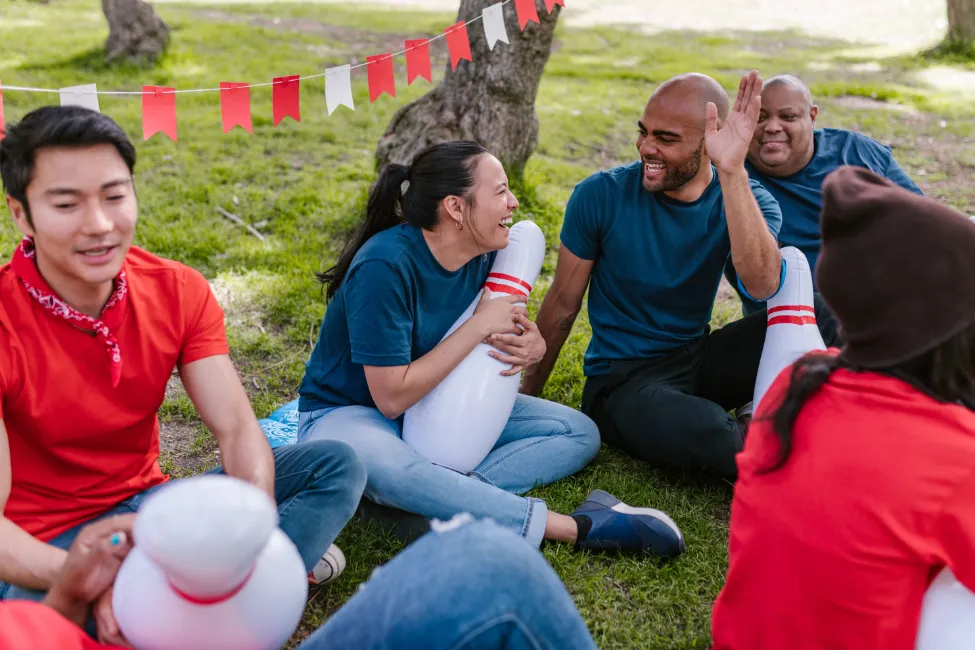Your Ultimate Guide to Planning a Retreat (Step-by-Step)

Organizing a retreat can be an overwhelming endeavor, especially if you’re new to the task.
But with the help of this guide, you’ll be able to plan and execute the perfect retreat for your group in no time.
From choosing a destination to budgeting and preparing activities, this ultimate step-by-step guide will walk you through each aspect of planning a retreat.
Whether you’re looking to plan a retreat by yourself, with coworkers, or with friends, this guide will give you all the information you need to successfully plan a personalized and unique retreat experience!
With these helpful instructions and advice, you’ll be well on your way to creating an unforgettable event that your group won’t soon forget!
Planning a Retreat: Step-by-Step Guide
1. Set Your Goals
Setting goals is important when planning a retreat because it allows you to have a clear idea of what you want to achieve during the retreat. Without goals, it can be difficult to determine whether or not the retreat was successful. Additionally, goals can help to keep participants focused and on track during the retreat.
Finally, goals provide a way to measure the success of the retreat. At the end of the retreat, it will be easier to determine whether or not it was successful if there were specific goals that were either met or not met.
A few questions you can ask yourself or your team to start thinking about your retreat goals could be:
- What do we value as a community?
- Is there a specific skill we want the participants to walk away with?
- What would success look like?
- What would we do if we had an unlimited budget?
This is your space to dream big. Throw some ideas out and see how they feel. Discuss different possibilities with your team and choose a goal that feels motivating, and inspiring, but also realistic.
2. Draft a Budget
A budget is a key part of any successful retreat, as it will help you determine how much money you have to work with and what activities and amenities can be included. It’s important to create a budget before getting too far into the planning process so that you don’t end up overspending.
When creating your budget, be sure to include all of your projected expenses like venue rental costs, food, transportation, and entertainment. However, also make sure to include some room for unexpected costs that may come up so that you’re not caught off guard.
If this is a retreat you plan to make an income from, this is also the time to start thinking about how much you will need to charge participants to make a profit on the retreat.
Once you’ve established a budget, it’s important to stick to it and be mindful of the amount of money you’re spending.
A few questions to ask yourself when making a budget are:
- What is the total cost of the retreat?
- How much do we need to charge each participant to cover costs and make a profit?
- What are our projected expenses?
- Is there room for unexpected expenses that may come up during the retreat?
- Does our spending align with our values and goals?
3. Choose the Location
Choosing the perfect retreat venue is a complex process that requires careful planning and consideration.
The first thing to consider is what kind of environment you want for your retreat. Depending on your desired outcome, some surroundings will be more suitable than others.
For example, if you’re planning an outdoor or nature-focused event, you might want to choose a location with lots of natural scenery and hiking trails. If your goal is more focused on relaxation and rejuvenation, then choosing a resort-style facility with beaches or spa amenities might be ideal. Are you hosting a wellness retreat or a business conference? Your goals will inform your decision.
Additionally, keep in mind the size of the facility and its capacity requirements. Make sure the retreat site can accommodate your expected number of guests comfortably and safely; it’s also important to consider whether they’ll need any kind of special accommodations such as wheelchair access or multiple language services.
When deciding on a location, be sure to check out all available amenities as well as proximity to other attractions like nearby restaurants, museums, or shopping centers in case participants decide to venture away from the retreat center. Remember, retreats don’t have to be helped at retreat centers.
Consider the convenience of transportation options in case some guests may be arriving from other locations or airports; finding a place close enough so that travel times are reasonable will help ensure that everyone arrives on time for events at the retreat center.
Finally, do thorough research into the facilities themselves before making your final decision; read online reviews from past guests who have stayed at each potential site so you can gather honest feedback about the possible benefits and drawbacks of various facilities ahead of time.
Don’t forget to ask questions about things like additional costs associated with food service or activities; understanding all these details upfront will help ensure that there aren’t any hidden surprises when it comes time for payment after booking your space!
4. Create an Agenda
A retreat agenda is a plan for the events and activities that will take place during the retreat, and should be based on the goals of the event.
When creating a successful retreat structure, it’s important to consider all of the elements that need to be covered, such as setting timelines, assigning roles, selecting topics and activities, identifying outcomes, and locking in the retreat dates.
First and foremost, it is important to determine how long your retreat will last. This will help you determine how much time needs to be allocated for each element of your agenda. Once you have an idea of your retreat timeline, you can create a timeline for each day or session within that duration.
It is also important to consider any breaks or free time in between sessions so people don’t become overly drained from too many hours of talking or activity.
Each day should have an overarching goal or purpose. For example, if you are having a team-building retreat then one day could be focused on problem-solving techniques while another day could focus on improving communication skills.
After choosing general goals for each day, assign tasks and roles for everyone attending the retreat as necessary. Assigning roles ensures that there is someone responsible for every aspect of planning out each session – this makes things much more organized and efficient!
Once tasks are assigned, it’s time to select topics and activities that align with the goals of each day at the retreat. It’s important to choose topics and activities that stimulate discussion but also energize participants so they stay engaged throughout the entire event.
Icebreaker games are always a great way to kick off any type of gathering – this help break the ice and get people comfortable talking with each other right away! Additionally, it’s beneficial to add some creative activities into your agenda such as group art projects or interactive discussions – this keeps people engaged and allows them to learn more about their fellow participants in relaxed ways beyond traditional means like lectures or presentations.
The end goal should always be kept in mind when creating a successful retreat schedule – this helps ensure that everything planned ties back into what needs to be achieved by the end of the event.
5. Finalize Logistics
Once you have a basic plan and agenda for your retreat, it’s time to book accommodations and organize transportation.
Logistics aren’t always the most exciting part of retreat planning, but it’s an essential step in ensuring the participants have a positive experience. So take the time to run through all the details and don’t leave this task to the last minute.
Here’s a brief checklist for making sure you’ve covered all the logistical planning:
- Booked accommodations
- Arranged arrival and departure options for participants if necessary
- Made plans for food during the retreat
- Scheduled any extra activities or excursions
- Booked speakers, if necessary
- Established effective communication channels for participants to receive updates
- Ordered merchandise, learning resources, or gifts for participants
Make sure to keep all these details in mind and communicate clearly with the participants before the event so that everyone is on the same page.
By taking care of these logistics, you’ll make sure your retreat can run smoothly and help ensure success!
6. Promote Your Retreat
When planning a retreat, promoting it is an essential step to ensure it is successful. Without the right promotional strategies, your event may fail to reach its intended audience and make a lasting impact.
To maximize the effectiveness of your promotional efforts and ensure as many people as possible attend your retreat, consider the following tips.
1. Identify Your Target Audience:
It’s important to understand who will benefit most from your retreat so you can focus your messaging on those individuals. Knowing who you are aiming to reach with your message helps you craft content that resonates with them and entices them to register for the event.
Conduct research beforehand to get an understanding of who would be interested in attending such an event and tailor all of your messaging accordingly.
2. Create Engaging Content:
Quality content is key when promoting a retreat; it’s what will draw in potential participants and compel them to attend.
Create content that highlights the unique value of attending the retreat by focusing on what attendees will take away from it – both tangible (skills or knowledge) and intangible (ease or comfort).
Use visuals such as photos or videos whenever possible for maximum impact with readers, particularly on social media platforms where visual engagement tends to be higher than text-based posts.
3. Utilize All Platforms:
To maximize exposure, promote your retreat across multiple digital platforms – social media accounts, email newsletters, blogs, etc., depending on where most of your target audience members spend their time online.
Leverage influencers relevant to the topic of your retreat as well; followers are more likely to trust recommendations from these industry leaders than they would from organizations they don’t recognize or haven’t worked with before.
4. Try Paid Advertising:
While organic methods should always form the foundation of any promotional strategy, paid advertising can help bring even more attention to your event if done correctly – extra exposure means more potential registrations!
Get familiar with metrics like cost per click (CPC), cost per impression (CPM), return on investment (ROI), and other KPIs that determine how effective each ad campaign has been so you can adjust accordingly and optimize results over time if necessary.
Creating buzz about a retreat is no easy task but taking the time to promote it properly can pay off significantly in terms of attendance numbers – and ultimately making sure that everyone has an enjoyable experience during their stay at the event itself! Follow these steps for successful promotion strategies when planning a retreat and set yourself up for success!
7. Follow Up After The Retreat
Following up with participants after a retreat gives you insight into how successful the retreat was and helps you make adjustments for future retreats.
The importance of getting feedback from your participants lies in the insights it provides into their experiences during the retreat and what they liked or disliked about it.
You can use this information to refine your retreat agenda, activities, and even location for future events. If a participant felt that certain activities were too long or too boring, you can adjust accordingly to make them more engaging.
Similarly, if a participant felt that certain topics weren’t discussed enough or needed more time dedicated to them, they can provide valuable insight into how to better allocate time during future events.
Getting feedback not only helps you improve the overall experience at your next event but also allows you to measure success on a deeper level.
Knowing what went well and what needs improvement enables you to make meaningful changes over time that directly impact how people respond to your retreats. It also allows you to focus on areas where participants are struggling or need more help or support so you can tailor your next event accordingly and create a better overall experience for everyone involved.
Additionally, gathering feedback from participants gives attendees an opportunity to share their thoughts and feelings about the event with organizers which makes them feel heard and appreciated as part of their involvement in the event.
This further boosts their engagement levels which can lead to enhanced participation by those who attend future events as well as improved overall morale among staff members who are involved in running these events.
FAQs
What should a retreat include?
A retreat should include activities and topics that will foster a sense of community, engagement, and learning for the participants.
These can range from team-building exercises to discussions on professional development topics or leadership strategies.
Depending on the objective of the retreat, it could also include workshops, guest speakers, networking sessions, or simulations. It is important to tailor your activities to achieve specific goals while considering participant interests and what would be most beneficial for them.
Additionally, including recreational activities such as games, sports or leisurely excursions can help break up the day and provide some much-needed relaxation time between focused talks and discussions.
Ultimately creating an enjoyable experience that attendees look forward to!
What makes a great retreat?
A great retreat is tailored to the needs and interests of the participants, has activities that foster learning, engagement, and community-building, and is designed to achieve specific goals.
Additionally, a retreat can include recreational activities such as games or sports breaks in order to provide attendees with a sense of relaxation and enjoyment during their stay at the event.
Having follow-up sessions after a retreat can also be beneficial in gathering feedback from participants which allows organizers to measure success on a deeper level while making meaningful changes for future events.
All of these aspects contribute to creating an enjoyable experience that attendees will look forward to!
How do you plan a spiritual retreat?
Planning a spiritual retreat requires thoughtful consideration and preparation. Firstly, determine your goals for the retreat – this could include activities such as meditation or yoga sessions, small group discussions on spiritual topics, individual reflection or journaling time, and/or creative projects that allow attendees to express themselves through art.
Next, decide what type of space best fits the needs of your event – from booking a venue with the capacity to accommodate all participants to choose an online platform for remote access – and select the appropriate tools for hosting group sessions if necessary.
More importantly, be mindful when selecting facilitators as they will play an instrumental role in providing guidance during each workshop while fostering a safe and inclusive environment throughout the duration of your retreat.
With careful planning, you can create a meaningful experience that both organizers and participants will cherish!





